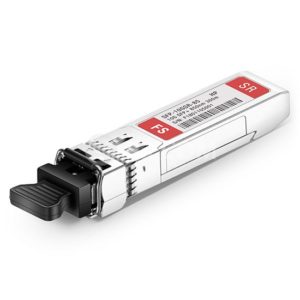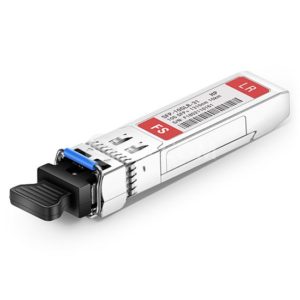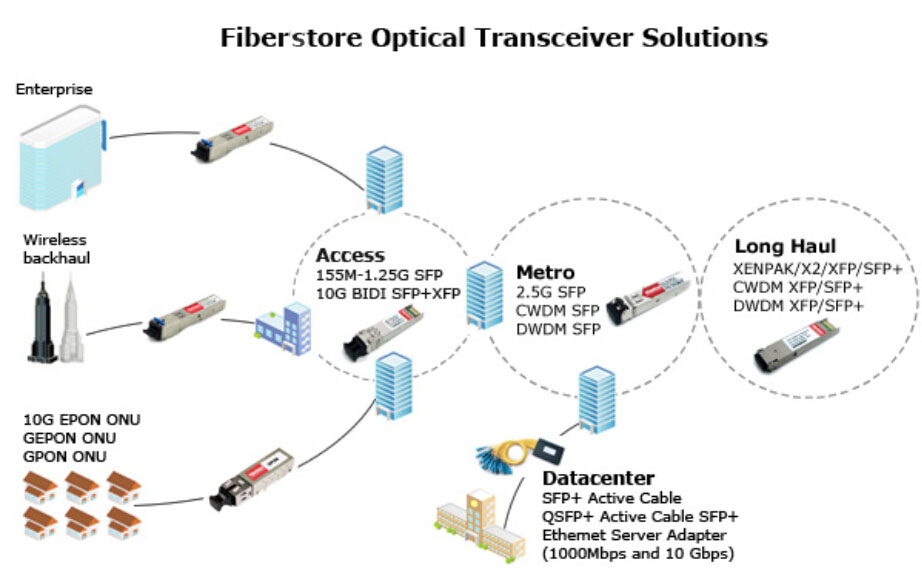Today, let’s turn to third-party transceiver modules rather than the original one which we have covered lots of topic about it. Third-party compatible optical module means the optical transceiver is offered by another manufacturer who can provide or produce the optics with the same specifications. For example, HPE J9150A compatible 10GBASE-SR SFP+ provided by FS.COM has the same specification with the original one produced by HP. The following part will mainly focus on the X132 10G SFP+ LC transceivers, especially J9150A vs J9151A.
J9150A: HP X132 10G SFP+ LC SR Transceiver
HP X132 10G SFP+ LC SR Transceiver is a 10-Gigabit transceiver in SFP+ form-factor. 10GBase-SR is one of the Ethernet specifications. HP X132 10G SFP+ LC SR transceiver complies with this standard specification, and the SR in this optical module model means short range. When it is integrated with multimode fibre, its transmission distance can reach up to 300 m. In addition, the wavelength of the 10G SFP+ SR optical module is 850 nm, which has the advantages of low cost, low power consumption, small size, and high density. In its name, HP is just a trademark of Hewlett-Packard Development Company. This kind of transceiver module is same with other normal 10G SFP+ SR transceivers in specification and function.
J9151A: HP X132 10G SFP+ LC LR Transceiver
Same with HP X132 10G SFP+ LC SR transceiver, HP X132 10G SFP+ LC LR transceiver is also a 10-Gigabit transceiver in SFP+ form-factor, but it conforms to 10GBase-LR Ethernet specification. Oppositely, LR stands for the long range. The transceiver supports the 10-Gigabit LR standard, providing 10-Gigabit connectivity up to 10 km on single-mode fibre. Its maximum transmission distance is 10 km on a single-mode optical fibre with a wavelength of 1310nm. It can actually reach a maximum of 25km. Moreover, It also has the advantages of miniaturization, low power consumption, and long transmission distance.
J9150A vs J9151A
| SFP+ Module | J9150A | J9151A |
| Wavelength | 850nm | 1310nm |
| Cable Length | 2m to 300m | 2m to 10km |
| Fibre Type | Multimode | Single Mode |
| Connector Type | LC | LC |
| Transceiver Form Factor | SFP+ | SFP+ |
Wavelength means the distance between two crests of the transmission signal. The longer wavelength means a longer transmission distance. As wavelength and fibre type are both the determining factor of transmission distance, we can say the biggest difference between J9150A and J9151A is the transmission distance.
Conclusion
From the above, we can conclude that the content of J9150A vs J9151A is not falling on which one is better, instead, it mainly argues the optimised choice in varied conditions. Except for the prefix—HP, these two transceivers are similar to a lot of 10G SFP+ with an LC connector. Whereas, due to the name—HP, the transceivers can be trustworthy and chosen by many people. The fact that HP SFP+ transceivers are widely acknowledged by the public encourages more manufacturer to produce them. These 10 Gigabit single-mode SFP+ and 10 Gigabit multimode SFP+ provided by FS.COM are engineered to the highest quality standards and are 100% HP compatible. Next time, we may cover the two other types of X132 10G SFP+ LC transceivers, that is HP X132 10G SFP+ LC LRM transceiver(J9152A) and HP X132 10G SFP+ LC ER transceiver (J9153A). Follow us, if you are interested in it.
Related Article: Three Popular 10GBASE-SR SFP+ Modules Introduction



